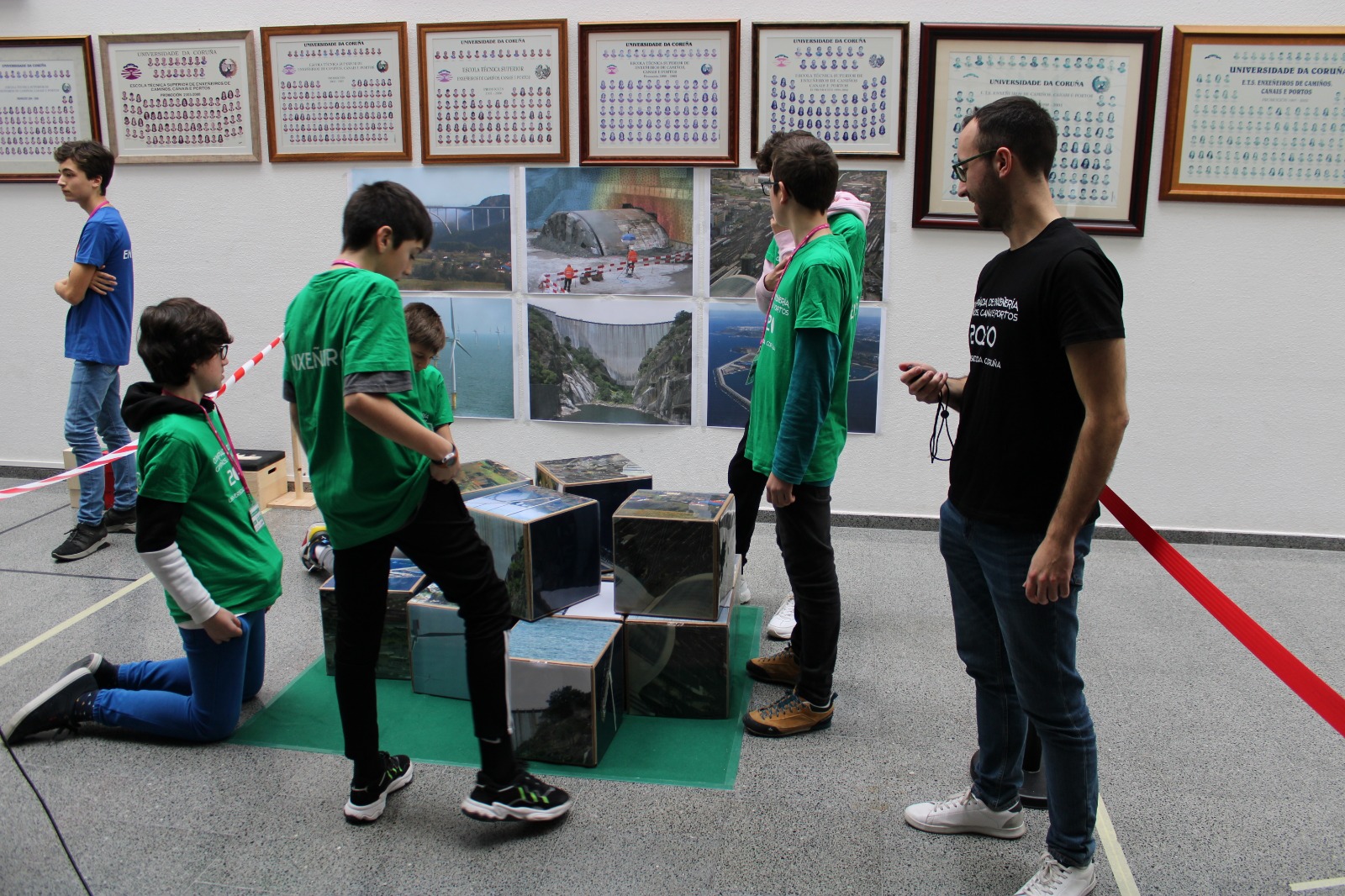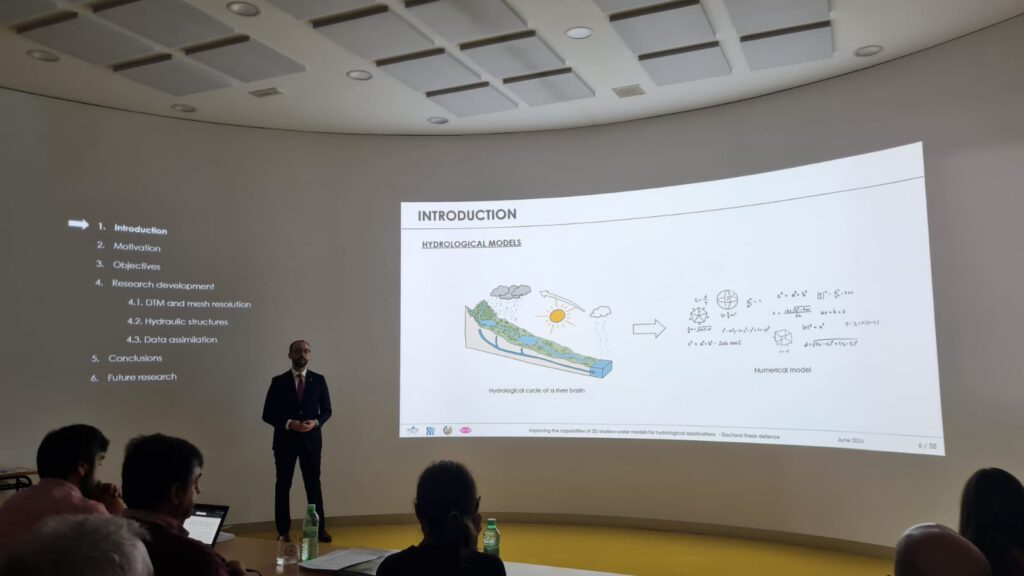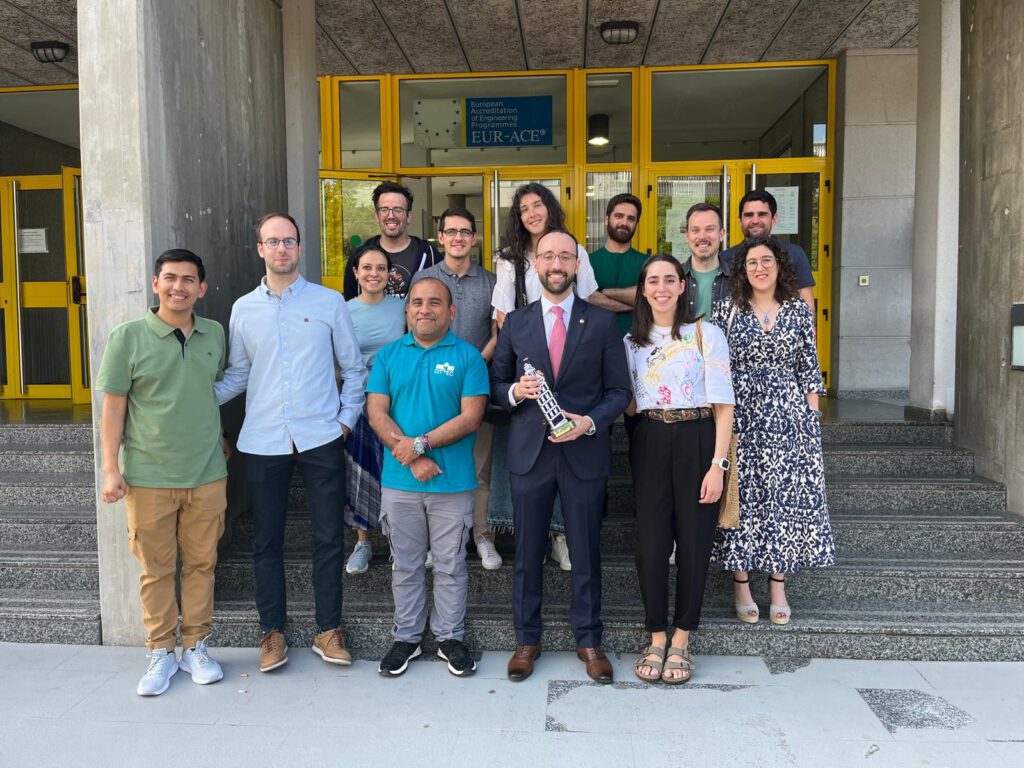IMPROVING THE CAPABILITIES OF 2D SHALLOW WATER MODELS FOR HYDROLOGICAL APPLICATIONS
Gonzalo García-Alén Lores
DOCTORAL THESIS
2024
Supervisors:
Luis Cea Gómez
Jerónimo Puertas Agudo
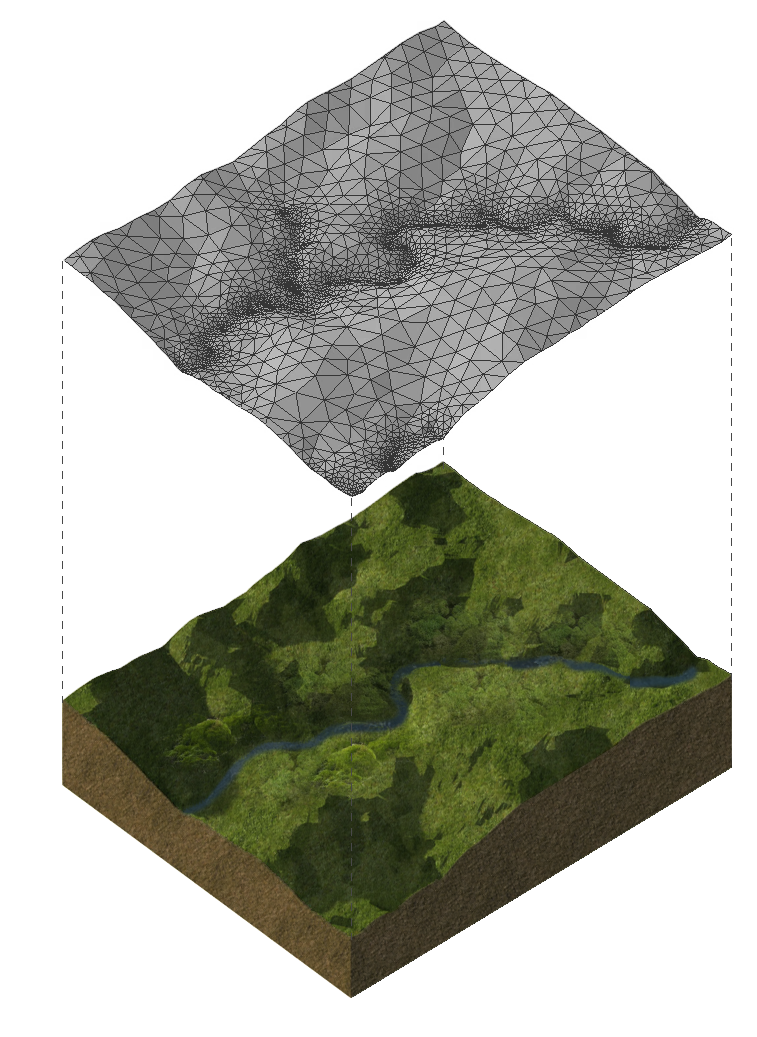
Abstract
The adoption of fully distributed models, especially those based on the 2D shallow water equations (2D-SWE), is becoming a common approach in rainfall-runoff simulations at the basin scale. These models have a great potential since they effectively capture the interactions of hydrological processes and their spatial variability. However, their use in practical applications is limited due to the substantial computational resources they necessitate for numerical solving, owing to their greater complexity, and the lack of well-established calculation methodologies. The objective of this thesis is to enhance the capabilities of hydrological models based on the 2D shallow water equations by optimizing the calculation and calibration processes, and validating their calculation methodology. Using Iber as a recognized 2D-SWE model, this research concluded a mesh resolution threshold from which the model provides comparable outflow results, validated the accurate representation of anthropogenic alterations of the river channel, and successfully employed two data assimilation approaches, even creating a new framework for parameter calibration. The findings presented hold significant applicability and potential for transfer to other 2D-SWE models.
Repository
García-Alén, G. (2024). Improving the capabilities of 2D shallow water models for hydrological applications. (Doctoral dissertation, Universidade da Coruña). http://hdl.handle.net/2183/37729.
Objectives of the thesis
The main objective of this doctoral thesis was to contribute to the state of knowledge in the application of the 2D shallow water equations (2D-SWE) to hydrology using the Iber model as a well-established 2D shallow water model. This involved understanding the limitations of the model and studying improvement measures in terms of the numerical model itself, in the calculation methodology, and in the application of new approaches and calculation tools.
To achieve this purpose, the research was divided into the specific objectives described below, identifying for each of them the aspects considered relevant and innovative in the field of this doctoral thesis:
- Specific Objective 1 (SO1): To evaluate the impact of Digital Terrain Model (DTM) resolution and mesh size on the reliability and performance of rainfall-runoff simulations based on the 2D-SWE. To investigate how variations in DTM and mesh resolution affect the results and computational efficiency of the Iber model.
- Specific Objective 2 (SO2): To evaluate the suitability of the Iber model in simulating anthropogenic modifications within natural catchments, with a specific emphasis on the modelling of weirs and bridges, while also considering the impact of reservoirs and dams. To investigate alternative techniques to enhance the model’s performance.
- Specific Objective 3 (SO3): To explore the application of data assimilation (DA) techniques in physically based hydrological models based on the 2D-SWE, with a focus on incorporating remote sensing data into small-scale models. To develop an automatic calibration tool to provide Iber modelers with flexible calibration options.
Thesis outline
The dissertation of this thesis was presented in the modality of a compendium of scientific papers. The results achieved during the thesis have been disseminated in five articles, four of them being in journals indexed by the Journal Citation Report (JCR). These JCR-indexed journals include the Journal of Hydrology (ranked Q1 with an Impact Factor of 6.4 accordingto the Journal Citation Reports 2022), Water (ranked Q2 with an Impact Factor of 3.4 according to the Journal Citation Reports 2022), and Journal of Hydraulic Engineering (ranked Q3 with an Impact Factor of 2.4 according to the Journal Citation Reports 2022). Additionally, one article was published in the Revista de Ingeniería del Agua, indexed by the Emerging Sources Citation Index (ESCI). Beyond scientific articles contributions, this research has been presented at two conferences, at international and national levels: 39th IAHR World Congress, Granada, Spain, and Jornadas de Ingeniería del Agua (JIA 2023), Cartagena, Spain. Also, the work conducted led to a manuscript that is currently undergoing review process for potential publication in the journal Environmental Modelling & Software (ranked Q2 with an Impact Factor of 4.9 according to the Journal Citation Reports 2022).
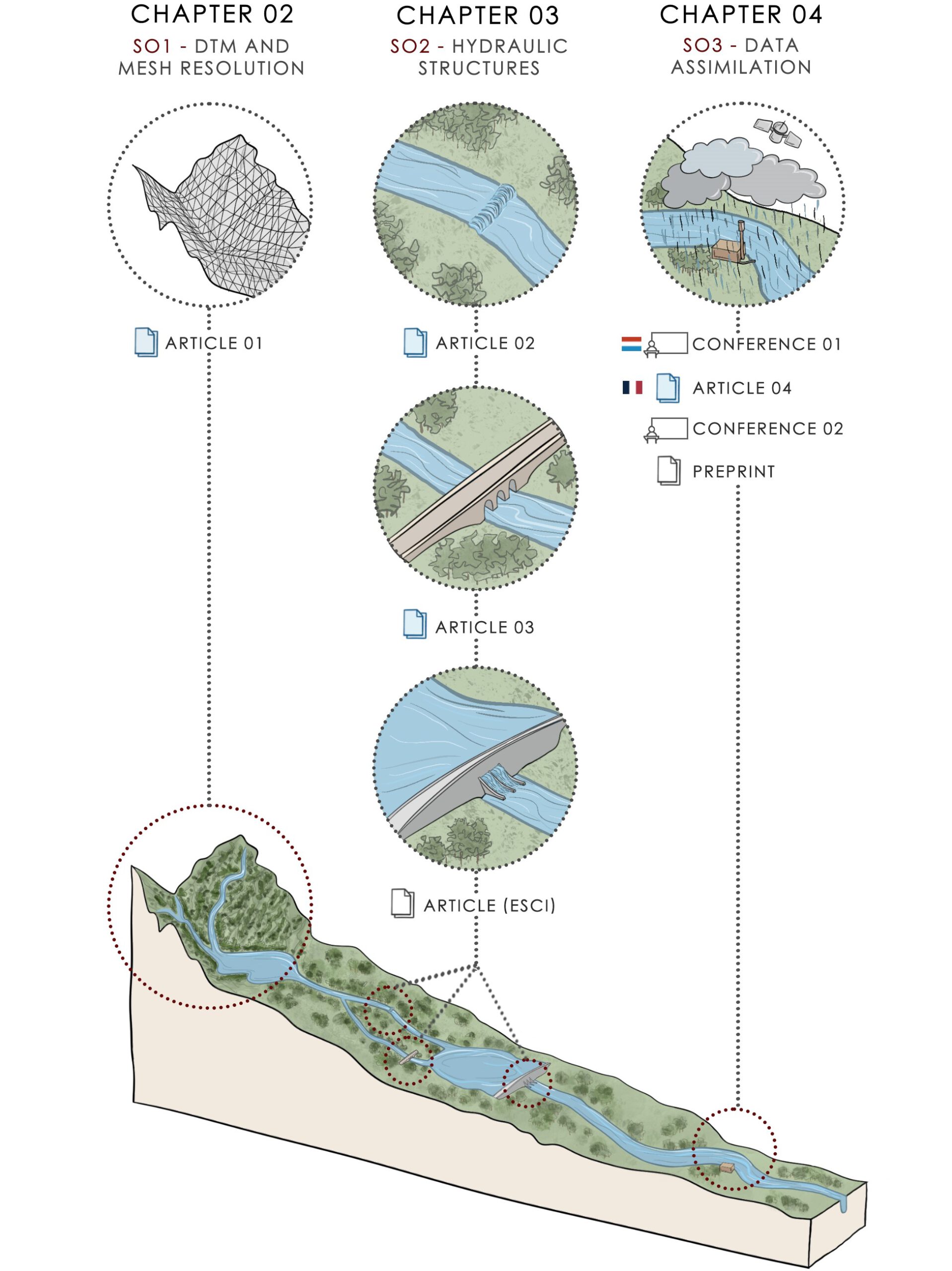
The set of these publications covers the specific objectives established, and therefore the overall objective of the thesis. In the figure, a graphical abstract of the thesis illustrates the relationship between each specific objective, publication, and chapter that constitute this document.
Chapter 1 summarises the main contents and results of the thesis and gives coherence and unity to the different studies that compose it, explaining how the objectives of the project were addressed. The remaining chapters are then organised in a way that each of them can be considered as an individual study, including its own specific state of the art, methodology, results, and conclusions.
Working with fully distributed models founded on the principles of 2D shallow water equations at basin scale often requires a large computational cost, which implies a restriction on the mesh size resolution. Thus, in practice, modellers need to find a compromise between spatial resolution, numerical accuracy, and computational cost. To address this challenge, Chapter 2 explores the impact of Digital Terrain Model (DTM) resolution and mesh size on the results and runtime of the Iber hydrological model. By modelling several rainfall events in different catchments using different DTMs and mesh resolutions, the research provides a comprehensive understanding of how the resolution of DTMs and mesh size influence the reliability and performance of the hydrological model. Seven rainfall events occurring in 4 hydrological basins were studied combining 3 freely distributed DTMs and 3 different mesh sizes.
Chapter 3 addresses the limitations encountered in simulating anthropogenic alterations of the basin and, taking Iber as numerical model, provides a detailed analysis of the accuracy of 2D shallow water models. This chapter is divided into three distinct parts. The first part examines the modelling of weirs, which presents challenges to 2D shallow water models due to the non-fulfilment of hydrostatic pressure assumptions. The second part focuses on the modelling of bridges within 2D-SWE models, highlighting the significant impact of the backwater effect generated by bridges, which can greatly increase the risk of flooding. The third part is dedicated to the development of a methodology for the incorporation of the influence of reservoirs and dams within 2D-SWE models. This methodology includes the incorporation of various components to accurately model the outflow discharge from the reservoir, such as weirs with and without gates, bottom outlets, and the flexibility to define a customized outflow curve that correlates the discharge with the reservoir level.
The difference in temporal and spatial scales between observed data and the model resolution poses a difficulty for effectively incorporating observed data into small-scale hydrodynamic modelling. Thus, in the last chapter (Chapter 4) innovative DA methods are explored, aiming to enhance the representation of spatial variability in parameters and processes. First, satellite-derived soil moisture and in situ-observed streamflow data are jointly assimilated into a high-resolution hydrological-hydrodynamic model based on the Iber software. The Tempered Particle Filter (TPF) is employed for the dual estimation of model state variables and parameters. The proposed approach is tested using twelve storm events within a 199 km2 catchment located in NW Spain. Moreover, in this chapter it is presented a novel automatic calibration tool that has been developed by integrating the capabilities of PEST with the Iber model. This tool offers users the flexibility to define the parameters for calibration and the observed values to be compared against the simulated results. It explores different scenarios, incorporating additional information, and considering the effects of measurement errors. Notably, this innovative tool represents a significant step forward as it is the first of its kind utilizing PEST for the calibration of a 2D-SWE model applied to hydrological simulations.
Related articles and communications
This doctoral thesis was presented to the Department of Civil Engineering of the Universidade da Coruña in compliance with the requirements for obtaining the title of Doctor in Civil Engineering. The dissertation was presented in the form of a compendium of scientific articles including the following referenced works:
- Research article 1:
García-Alén, G., González-Cao, J., Fernández-Nóvoa, D., Gómez-Gesteira, M., Cea, L., & Puertas, J. (2022). Analysis of two sources of variability of basin outflow hydrographs computed with the 2d shallow water model iber: digital terrain model and unstructured mesh size. Journal of Hydrology, 612, 128182. https://doi.org/10.1016/j.jhydrol.2022.128182. - Research article 2:
García-Alén, G., García-Fonte, O., Cea, L., Pena, L., & Puertas, J. (2021). Modelling weirs in two-dimensional shallow water models. Water, 13(16), 2152. https://doi.org/10.3390/w13162152. - Research article 3:
Cea, L., Vila, G., García-Alén, G., Puertas, J., & Pena, L. (2022). Hydraulic Modeling of Bridges in Two-Dimensional Shallow Water Models. Journal of Hydraulic Engineering, 148(8), 06022006. https://doi.org/10.1061/(ASCE)HY.1943-7900.0001992. - Research article 4:
García-Alén, G., Hostache, R., Cea, L., & Puertas, J. (2023). Joint assimilation of satellite soil moisture and streamflow data for the hydrological application of a two-dimensional shallow water model. Journal of Hydrology, 129667. https://doi.org/10.1016/j.jhydrol.2023.129667.
In addition, this thesis work was complemented by the publication of an article in a journal indexed in the Emerging Sources Citation Index (ESCI), two papers presented at conferences, one at the international level and another at the national level; and the writing of a manuscript that was submitted for publication to the journal Environmental Modelling & Software (under review during the thesis defense). The works are cited below:
- Research article (ESCI indexed):
García-Alén, G., García-Feal, O., Cea, L., & Puertas, J. (2023). Implementación de embalses en cálculos hidrológicos con Iber. Revista de Ingeniería del Agua, 27(1), 59-72. https://doi.org/10.4995/ia.2023.18750. - Conference paper:
García-Alén, G., Hostache, R., Matgen, P., Cea, L., Puertas, J., (2022). Assimilation of SMAP soil moisture data into a fully distributed hydrological model using a Tempered Particle Filter (TPF): the Landro basin in Spain as a test case, in: 39th IAHR World Congress, Granada, Spain; Ortega-Sánchez, Miguel (Ed.), pp. 3564–3573. https://doi.org/10.3850/IAHR-39WC2521711920221031. - Conference paper:
García-Alén, G., Montalvo, C., Cea, L., Puertas, J., (2023). Simulación de inundaciones pluviales en el núcleo urbano de Sada (Galicia) con Iber y PEST, in: VII Jornadas Ingeniería del Agua (JIA), Cartagena, Spain; Castillo, Luis Gerardo, García, Juan Tomás, Carrillo, José María (Eds.), pp. 80-83. ISBN: 978-84-17853-72-3. - Research article (under review during the submission of the thesis):
García-Alén, G., Montalvo, C., Cea, L., & Puertas, J. (2024). Iber-PEST: Automatic calibration in fully distributed hydrological models based on the 2d shallow water equations. Environmental Modelling & Software, 106047. https://doi.org/10.1016/j.envsoft.2024.106047
PhD Defence
The PhD defence took place on June 4 2024 in the CITEEC. Here the link to the presentation.
Other work carried out within the framewok of the thesis
Research stays in the Luxembourg Institute of Science and Technology (LIST), Luxembourg, and in the Maison de la Télédétection, Montpellier, France. Both stays were supervised by the researcher Renaud Hostache.
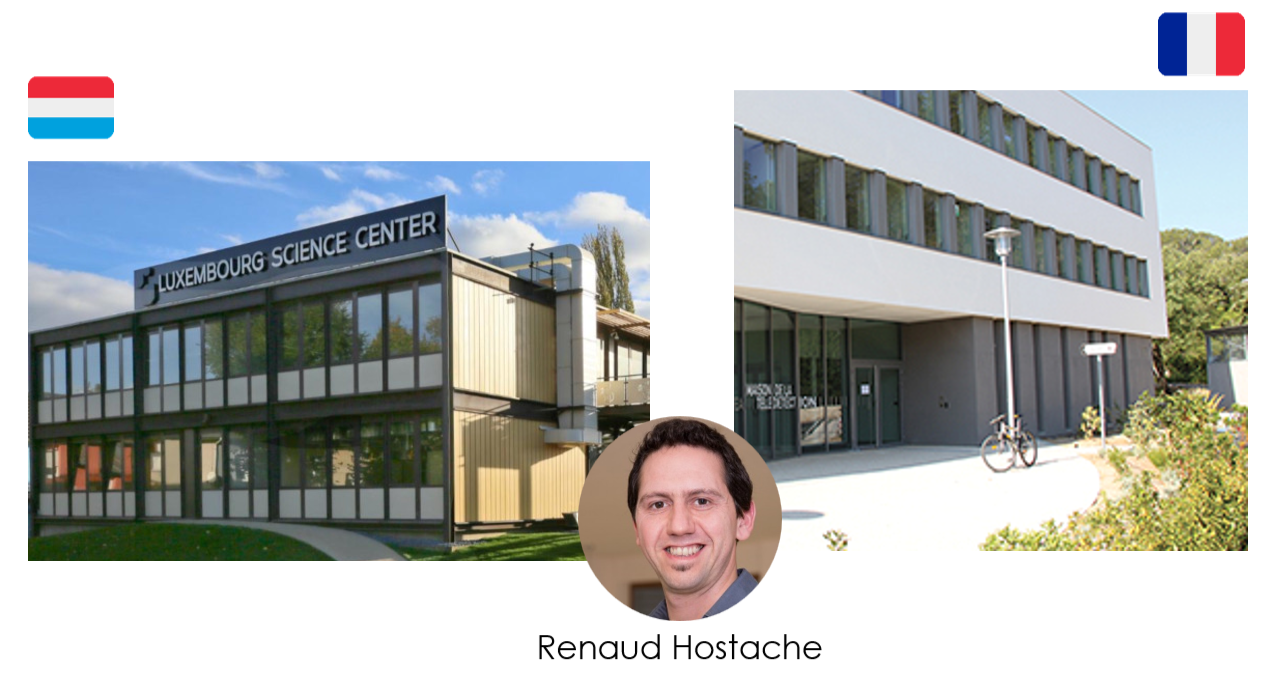
Participation in national and international projects. In particular, the participation in the AAFLOODS involved an important interation with other partners from different European countries.
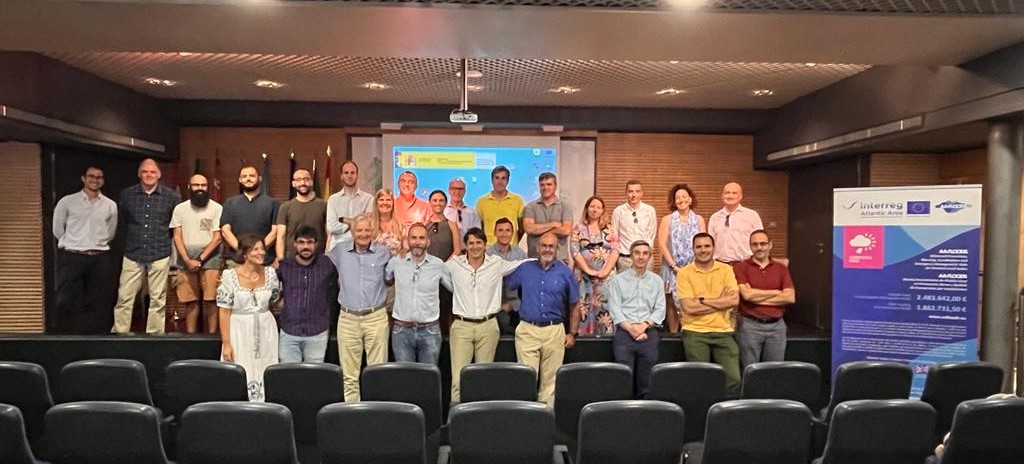
Participation in national and international congresses as a speaker, chair and organiser. Among the highlights are the participation in the organisation IAHS Scientific Assembly 2022 (Montpellier, France) and of the 3rd and 4th Young professional congress (online).
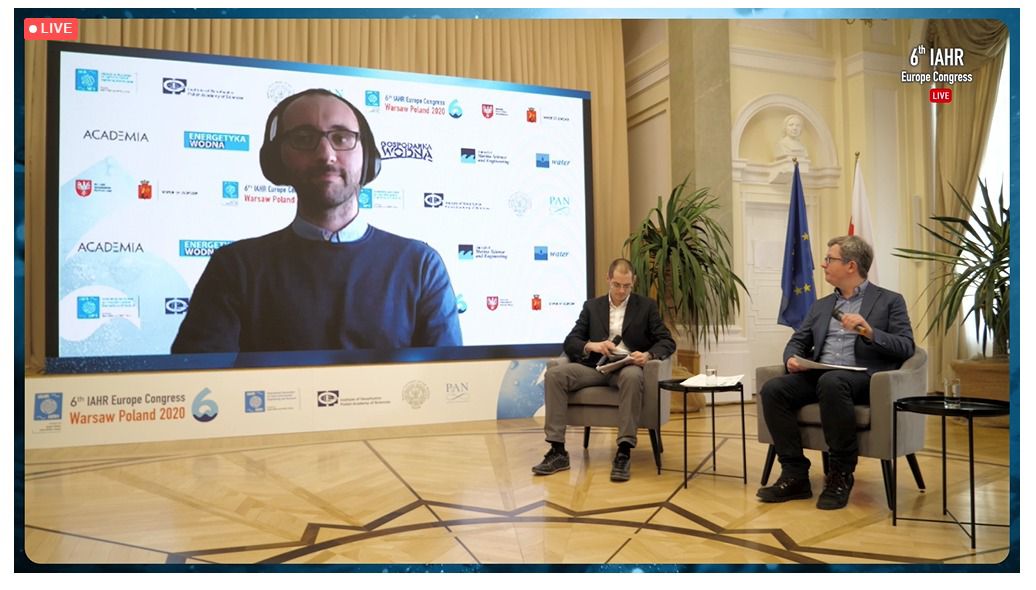
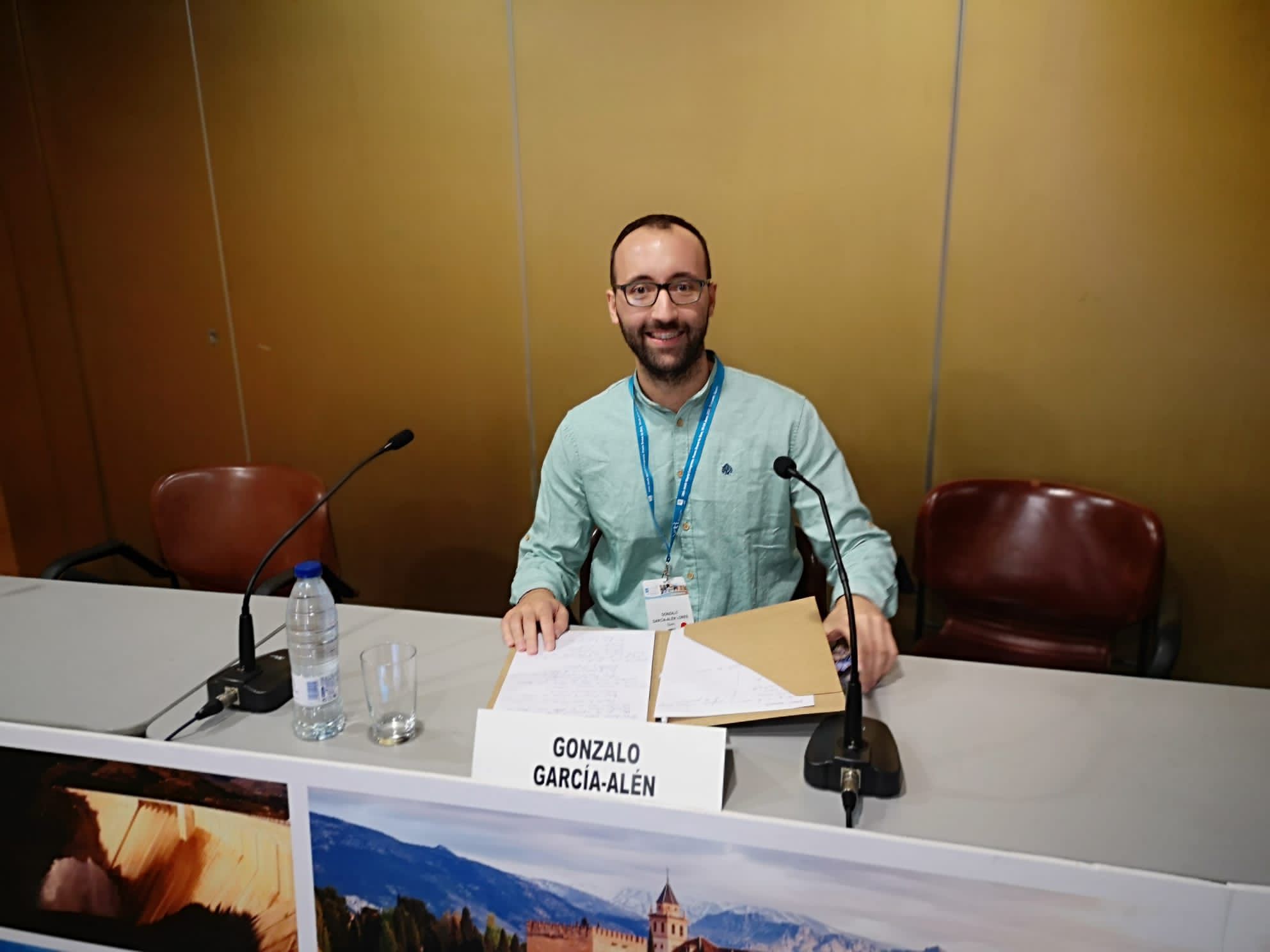
Participation in Iber training courses both as a student and as a professor.
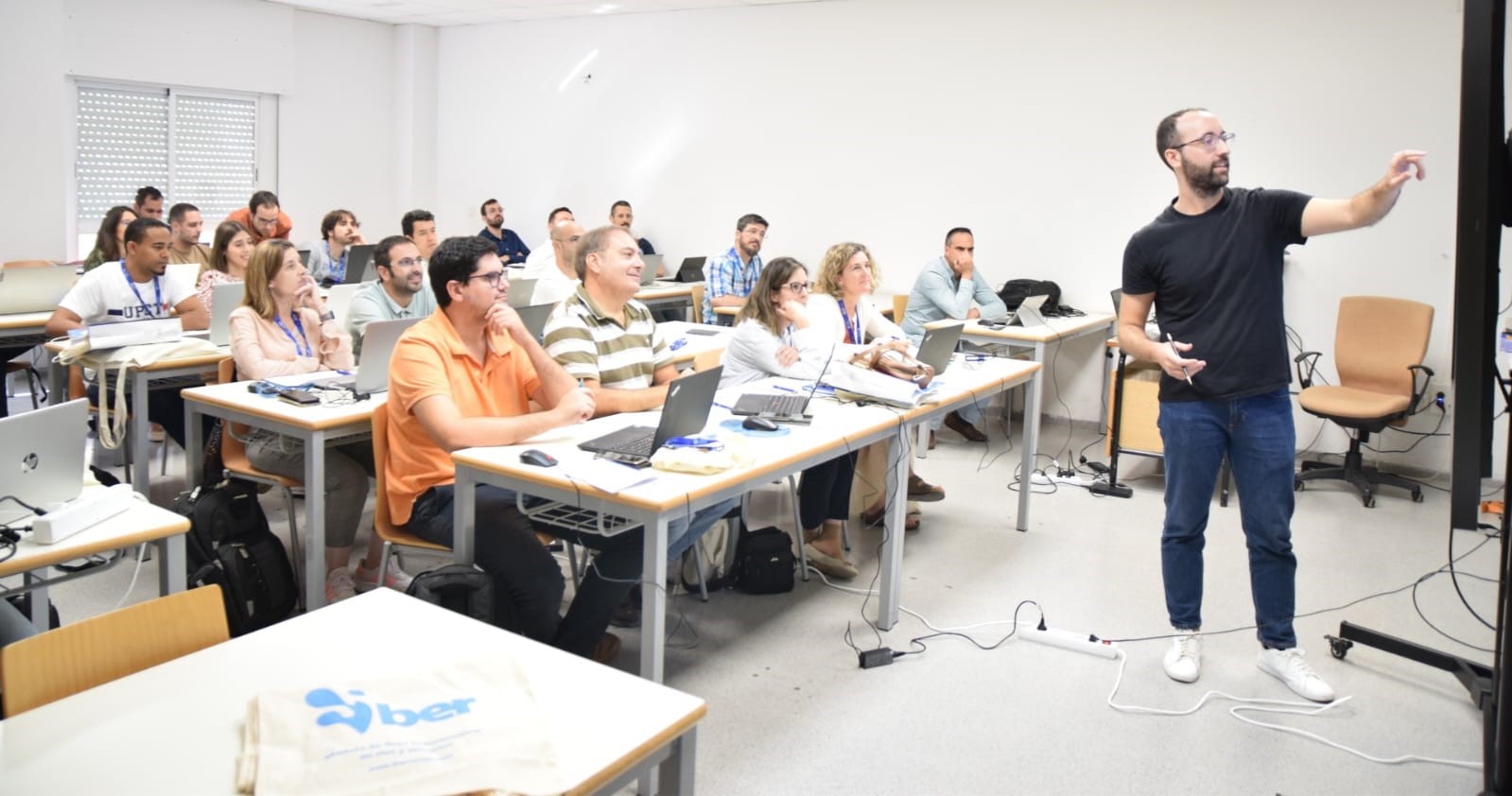
PEST course held in Bordeaux, France, by John Doherty.
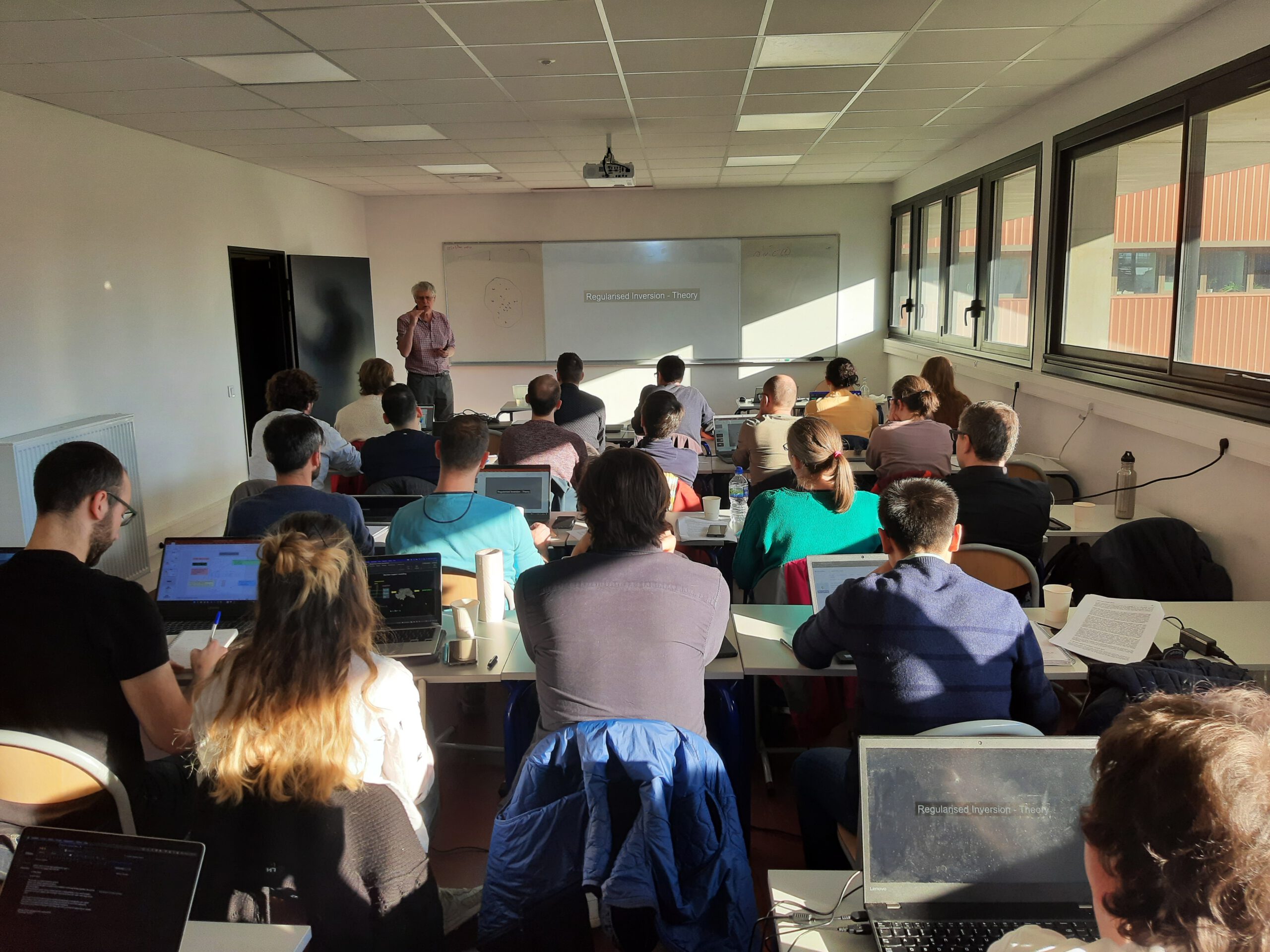
Participation as a speaker at international seminars.

Participation in the IAHR Spain YPN as an academic link. This association of young professionals has, among other objectives, the dissemination of the work carried out by its members.
Participation leading guided tours of the hydraulics laboratory at CITEEC.
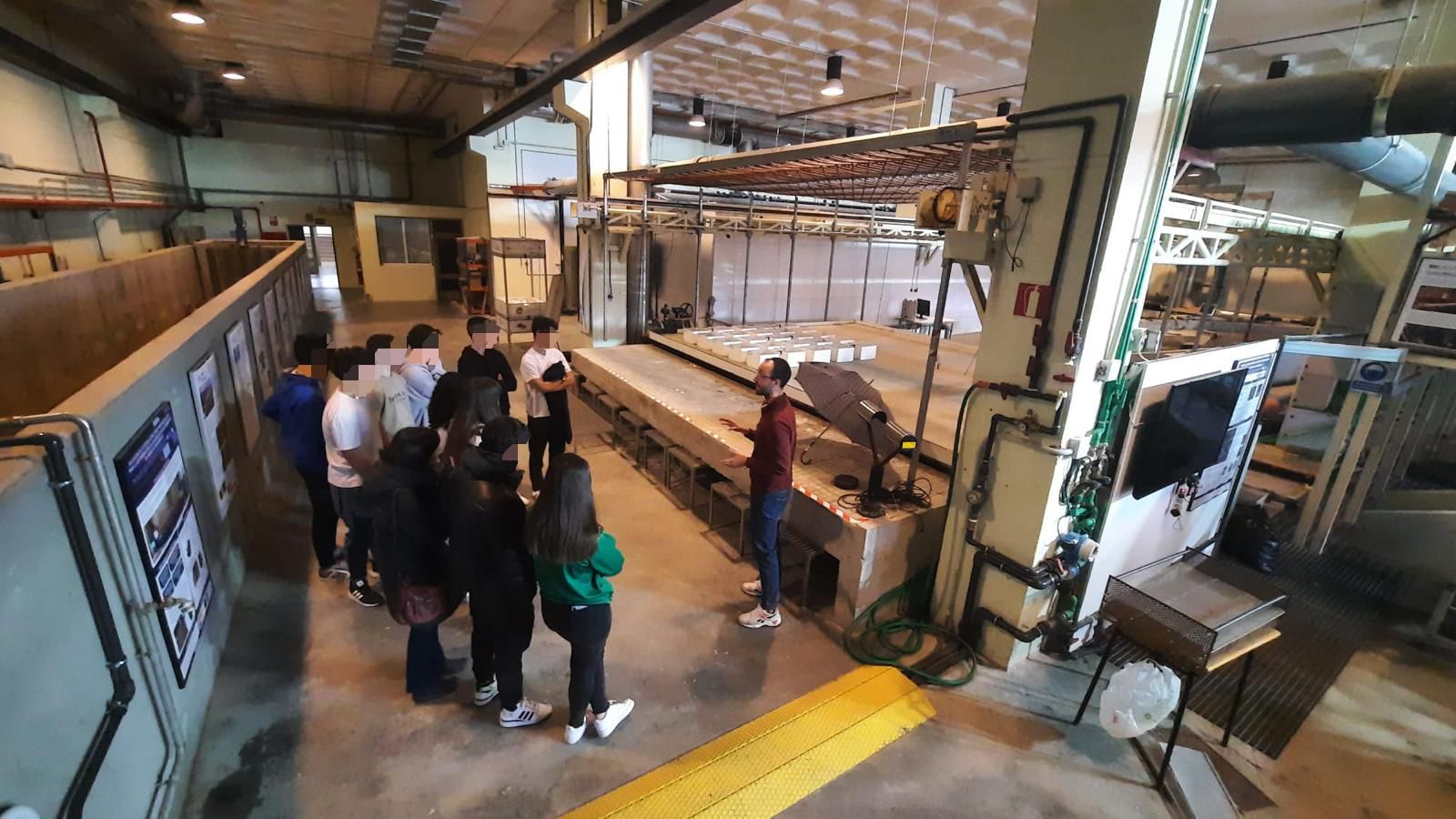
Winner of the 2nd IAHR Young Professionals Hydro-Environment challenge.
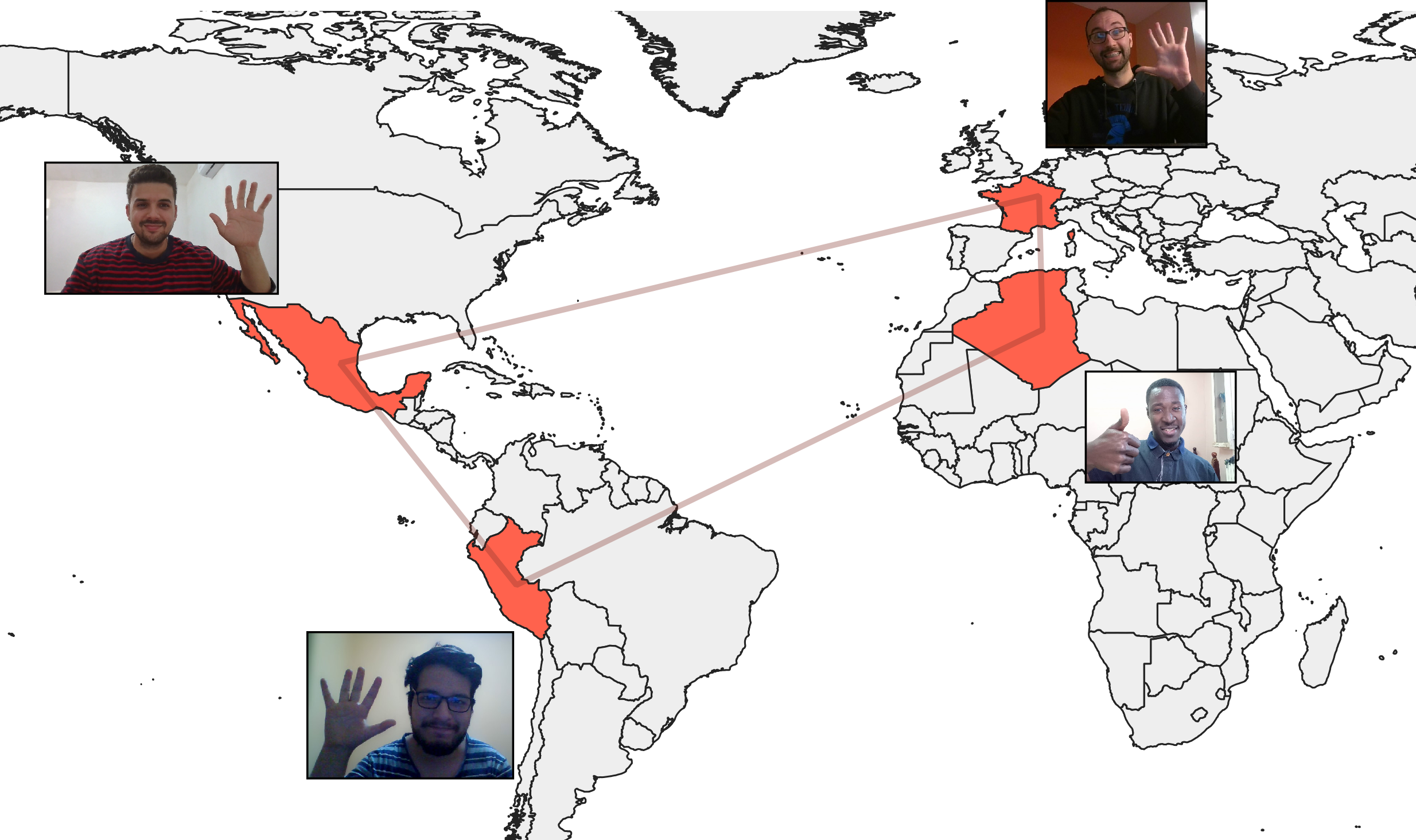
Participation in scientific olympiads and visits of secondary school students:
